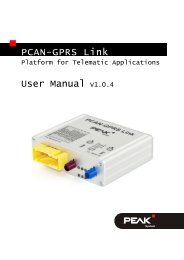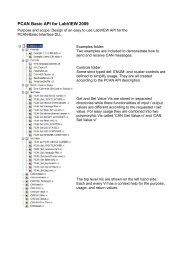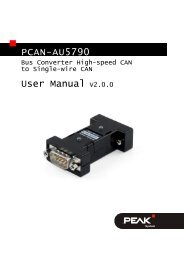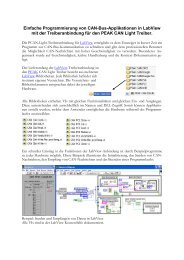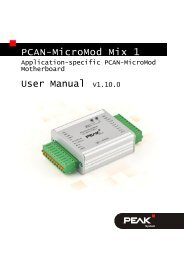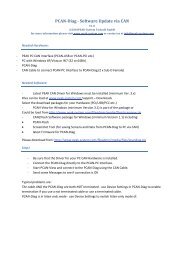1 PLIN-API Documentation - PEAK-System
1 PLIN-API Documentation - PEAK-System
1 PLIN-API Documentation - PEAK-System
Create successful ePaper yourself
Turn your PDF publications into a flip-book with our unique Google optimized e-Paper software.
3.1 The LIN Client <strong>PLIN</strong> <strong>API</strong> <strong>Documentation</strong> Selecting a Hardware<br />
Selecting a Hardware ( see page<br />
6)<br />
This section contains Information about locating and selecting a LIN hardware for<br />
connection.<br />
Configuring a Client ( see page 7) This section contains Information about configuring basic parameters of a client.<br />
3.1.1 Creating a Client<br />
A <strong>PLIN</strong> client is an entity registered in the <strong>PLIN</strong> system which allows an user application to communicates on a LIN bus. The<br />
registration process is done using the function LIN_RegisterClient ( see page 106) which allocates the necessary<br />
information needed for the interaction User-<strong>API</strong>-Hardware.<br />
A client is identified twice on the <strong>PLIN</strong> system, one time through a name or label given by the user of the <strong>PLIN</strong> <strong>API</strong> at the<br />
moment of registration and, the most important, a unique handle which is returned by the function LIN_RegisterClient ( see<br />
page 106) when a client is successfully registered. This handle will be used for almost all calls to the <strong>API</strong> and for this reason<br />
it should be saved by the client application as long as a <strong>PLIN</strong> client is needed. When a <strong>PLIN</strong> client is not needed anymore,<br />
the opposite function, LIN_RemoveClient ( see page 107), should be called in order to liberate the resources occupied by<br />
that client. It is not necessary to disconnect a client (eg. using LIN_DisconnectClient ( see page 108)) before calling the<br />
LIN_RemoveClient ( see page 107) function. The disconnection is intrinsically done.<br />
See Also<br />
Selecting a Hardware ( see page 6)<br />
LIN_RegisterClient ( see page 106) (.NET: RegisterCleint)<br />
LIN_RemoveClient ( see page 107) (.NET: RemoveClient ( see page 52))<br />
LIN_DisconnectClient ( see page 108) (.NET: DisconnectClient ( see page 53))<br />
3.1.2 Selecting a Hardware<br />
After having a client registered in the <strong>PLIN</strong> system, a hardware can be connected using the LIN_ConnectClient ( see page<br />
108) function, in order to participate in a communication. A client must use the <strong>API</strong> to get connected to a hardware present in<br />
the system.<br />
The way to identify a hardware in the <strong>PLIN</strong> system is analog to the clients, using handles. The <strong>PLIN</strong> system assigns a<br />
handle, beginning with 1, to each LIN hardware registered in the system. A client application can ask for the available<br />
hardware, using the function LIN_GetAvailableHardware ( see page 117) which returns an array of handles from all LIN<br />
hardware available for connection.<br />
In many cases it is needed to physically identify a hardware before a client get connected, eg. when a computer has more<br />
than one LIN devices connected to different LIN busses. In this case, a client application can use the function<br />
LIN_IdentifyHardware ( see page 124) to identify a hardware. Calling this function with a valid hardware handle as<br />
parameter causes the owner of that handle to blink its LED several times, leaving it recognizable.<br />
The last step selecting a hardware is to connect the wanted hardware by using the function LIN_ConnectClient ( see page<br />
108). Completes the function successfully, means that the caller (<strong>PLIN</strong> client handle) was successfully associated to the<br />
hardware represented by the given hardware handle.<br />
A client can also disconnect a hardware connected before, using the opposed function LIN_DisconnectClient ( see page<br />
108). This function receives two handles, one representing the client requesting a separation and the other representing the<br />
hardware to disconnect. In similar way as by connecting, a client application can use the function LIN_IdentifyHardware (<br />
see page 124) to identify the hardware to disconnect.<br />
6<br />
3



![English - Low Quality [7.2 MB] - PEAK-System](https://img.yumpu.com/5931738/1/184x260/english-low-quality-72-mb-peak-system.jpg?quality=85)

